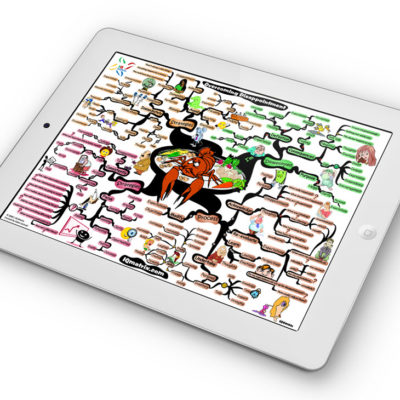The Emotional Eating IQ Matrix explores how to take control of your cravings and escape the cycle of emotional eating. Emotional hunger is very different from physical hunger. When, however, we are caught up in our emotions, it’s difficult to recognize the difference. People who struggle with emotional eating also struggle emotionally. Eating becomes a coping mechanism that helps them handle their emotions.
Emotional eating, however, never solves problems and will typically manifest in feelings of guilt, regret, and shame. The key, is, therefore, to find methods for managing those difficult emotions in more optimal ways. And food must no longer be used as a comfort mechanism.
This map breaks down what emotional eating is about, explores two types of hunger, breaks down various emotional triggers, and walks you through how to overcome the cycle of emotional eating.
Here is a quick breakdown of each branch of the Emotional Eating mind map.
- Emotional Eating: The first branch of this map explores what it means to eat emotionally. Emotional eating is, of course, a habit that we develop over time. As such, it’s also a habit that we can replace if we choose more optimal ways of responding to life’s difficulties. As you work your way through this branch you will also come across several self-analysis questions that will help you pinpoint whether you typically fall victim to emotional eating.
- Types of Hunger: The second branch of this map breaks down the two types of hunger that people typically experience. The first type of hunger is known as emotional hunger. This is a hunger that comes on suddenly and is accompanied by heavy cravings. The second type of hunger is physical hunger which comes on more gradually and is accompanied by a growling stomach and lightheadedness. Understanding the difference between these two types of hunger will help you take responsibility for your emotional eating habits.
- Emotional Eating Triggers: The third branch of this map helps you understand and identify probable emotional eating triggers. Being consciously aware of these triggers will help you to deal with and better manage your emotional eating patterns and responses to stressful situations.
- Overcoming Emotional Eating: The final two branches break down a four-step process that will help you to progressively eliminate your emotional eating habits. This process involves keeping an emotional eating journal, dealing with emotional eating triggers, learning how to manage your emotions and cravings, and developing healthy habits and a more supportive lifestyle.
This map provides a roadmap and framework for overcoming the cycle of emotional eating. Referencing it regularly and committing it to memory will help you to embed these concepts and ideas into your subconscious mind.
A mind map, of course, does this beautifully because it mirrors the synaptic connections made in your brain as you try to establish new habits of thought and behavior. It brings together key concepts and ideas that help your brain to fully integrate and process this information. The brain, subsequently, rewires itself as it attempts to establish new habits of mind. It’s an ideal tool for creating lasting change and transformation.
Stick with these principles, memorize and incorporate them into your life and you will progressively begin turning your emotional eating habits around. No longer will you view food as a source of comfort that helps diminish your life’s problems. You will instead use food only to help satiate your physical hunger.
When you purchase the Emotional EatingIQ Matrix you will receive:
- A PDF copy of the IQ Matrix, which you can use for printing in high resolution.
- A JPG image file of the IQ Matrix, which is ideal for viewing on tablets and mobile devices.
- A Desktop Background version of the map you can use for reference on your computer.
- A MindManager file for those who wish to edit the content of the IQ Matrix.
Additional visual resources and variations of this IQ Matrix might be added to your account page at no extra cost in the future.










